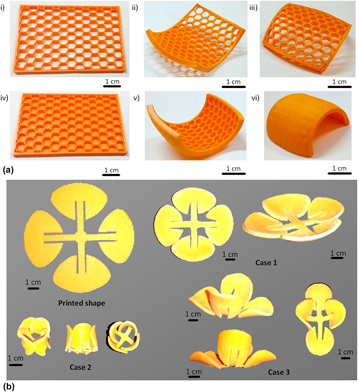Crossref Citations
This article has been cited by the following publications. This list is generated based on data provided by
Crossref.
McCracken, Joselle M.
Rauzan, Brittany M.
Kjellman, Jacob C. E.
Su, Hanxiao
Rogers, Simon A.
and
Nuzzo, Ralph G.
2019.
Ionic Hydrogels with Biomimetic 4D‐Printed Mechanical Gradients: Models for Soft‐Bodied Aquatic Organisms.
Advanced Functional Materials,
Vol. 29,
Issue. 28,
Selva Priya, M
Naresh, K
Jayaganthan, R
and
Velmurugan, R
2019.
A comparative study between in-house 3D printed and injection molded ABS and PLA polymers for low-frequency applications.
Materials Research Express,
Vol. 6,
Issue. 8,
p.
085345.
Andrew, J Jefferson
Ubaid, Jabir
Hafeez, Farrukh
Schiffer, Andreas
and
Kumar, S
2019.
Impact performance enhancement of honeycombs through additive manufacturing-enabled geometrical tailoring.
International Journal of Impact Engineering,
Vol. 134,
Issue. ,
p.
103360.
Alam, Fahad
Shukla, Vishnu Raj
Varadarajan, K.M.
and
Kumar, S.
2020.
Microarchitected 3D printed polylactic acid (PLA) nanocomposite scaffolds for biomedical applications.
Journal of the Mechanical Behavior of Biomedical Materials,
Vol. 103,
Issue. ,
p.
103576.
Mazhari, Arash Alex
Zhang, Alan
Ticknor, Randall
Swei, Sean
Hyde, Elizabeth
and
Teodorescu, Mircea
2020.
Printing and Programming of In-Situ Actuators.
p.
445.
Salimon, A.I.
Senatov, F.S.
Kalyaev, V.
and
Korsunsky, A.M.
2020.
3D and 4D Printing of Polymer Nanocomposite Materials.
p.
161.
Liu, Tianzhen
Liu, Liwu
Zeng, Chengjun
Liu, Yanju
and
Leng, Jinsong
2020.
4D printed anisotropic structures with tailored mechanical behaviors and shape memory effects.
Composites Science and Technology,
Vol. 186,
Issue. ,
p.
107935.
Jang, Hun Soo
Yoo, Seonggwang
Kang, Seong Hyeon
Park, Jongjun
Kim, Gi‐Gwan
and
Ko, Heung Cho
2020.
Automatic Transformation of Membrane‐Type Electronic Devices into Complex 3D Structures via Extrusion Shear Printing and Thermal Relaxation of Acrylonitrile–Butadiene–Styrene Frameworks.
Advanced Functional Materials,
Vol. 30,
Issue. 5,
Alam, Fahad
Varadarajan, K.M.
and
Kumar, S.
2020.
3D printed polylactic acid nanocomposite scaffolds for tissue engineering applications.
Polymer Testing,
Vol. 81,
Issue. ,
p.
106203.
Wang, Yanan
and
Li, Xiang
2020.
An accurate finite element approach for programming 4D-printed self-morphing structures produced by fused deposition modeling.
Mechanics of Materials,
Vol. 151,
Issue. ,
p.
103628.
Verma, Pawan
Bansala, Taruna
Chauhan, Sampat Singh
Kumar, Devendra
Deveci, Suleyman
and
Kumar, S.
2021.
Electromagnetic interference shielding performance of carbon nanostructure reinforced, 3D printed polymer composites.
Journal of Materials Science,
Vol. 56,
Issue. 20,
p.
11769.
Kousiatza, Charoula
and
Karalekas, Dimitris
2021.
Experimental study of fabrication‐induced residual strains and distortions in polymeric square plates built using fused deposition modeling process.
Material Design & Processing Communications,
Vol. 3,
Issue. 2,
Pivar, Matej
Gregor-Svetec, Diana
and
Muck, Deja
2021.
Effect of Printing Process Parameters on the Shape Transformation Capability of 3D Printed Structures.
Polymers,
Vol. 14,
Issue. 1,
p.
117.
Yamamura, Shunsuke
and
Iwase, Eiji
2021.
Hybrid hinge structure with elastic hinge on self-folding of 4D printing using a fused deposition modeling 3D printer.
Materials & Design,
Vol. 203,
Issue. ,
p.
109605.
Andrew, J. Jefferson
Alhashmi, Hasan
Schiffer, Andreas
Kumar, S.
and
Deshpande, Vikram S.
2021.
Energy absorption and self-sensing performance of 3D printed CF/PEEK cellular composites.
Materials & Design,
Vol. 208,
Issue. ,
p.
109863.
Dhakal, Hom Nath
and
Ismail, Sikiru Oluwarotimi
2021.
Sustainable Composites for Lightweight Applications.
p.
121.
Verma, Pawan
Ubaid, Jabir
Schiffer, Andreas
Jain, Atul
Martínez-Pañeda, Emilio
and
Kumar, S.
2021.
Essential work of fracture assessment of acrylonitrile butadiene styrene (ABS) processed via fused filament fabrication additive manufacturing.
The International Journal of Advanced Manufacturing Technology,
Vol. 113,
Issue. 3-4,
p.
771.
Garces, Irina Tatiana
and
Ayranci, Cagri
2021.
Advances in additive manufacturing of shape memory polymer composites.
Rapid Prototyping Journal,
Vol. 27,
Issue. 2,
p.
379.
Haleem, Abid
Javaid, Mohd
Singh, Ravi Pratap
and
Suman, Rajiv
2021.
Significant roles of 4D printing using smart materials in the field of manufacturing.
Advanced Industrial and Engineering Polymer Research,
Vol. 4,
Issue. 4,
p.
301.
Verma, Pawan
Schiffer, Andreas
and
Kumar, S.
2021.
Thermo-resistive and thermo-piezoresistive sensitivity of carbon nanostructure engineered thermoplastic composites processed via additive manufacturing.
Polymer Testing,
Vol. 93,
Issue. ,
p.
106961.



